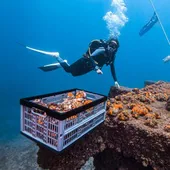Dive down to the coral trees of Spain's Costa Tropical
The Dendrophyllia ramea is usually found at depths of 30m or more, but on the coast of Andalucía it can be seen at just 27m, allowing more divers to admire this spectacular marine fauna
Alekk M. Saanders
Costa Tropical
Wednesday, 31 July 2024, 11:21
On the Costa Tropical, between Marina Este and Punto de la Mona, there are gardens where orange corals grow. They come in a variety. SUR in English has already written about Astroides calycularis, the best known orange coral in Andalusian waters. Its presence in shallow waters makes it accessible to divers and even regular snorkellers. However, there is another orange tree coral that prefers deeper waters.
The orange tree-like coral Dendrophyllia ramea belongs to the Atlantic-Mediterranean coral, considered a natural decoration of the seabed. The species was first described in 1758 by the Swedish naturalist Linnaeus. However, the coral still remains quite mysterious. Knowledge about Dendrophyllia ramea is quite scarce. Some biological information comes from experiments conducted in aquariums.
Little-known beauty
David Romero, director of the Centro Buceo España, located in La Herradura, knows about this orange coral from his own experience. He has been admiring this orange beauty for 11 years, almost daily.
“One of the reasons the orange coral Dendrophyllia ramea is so special is its unique appearance. Each colony is made up of small branching structures, which gives the coral a graceful appearance. The population of this hard but fragile coral consists mainly of many solitary corallites and colonies of varying sizes, some of which reach a maximum height of about one metre. The corallite calyxes are about nine millimetres in diameter and 11 millimetres high. They are arranged laterally and in two opposite rows. The polyps are white and the coinosarc is orange,” David Romero told SUR in English.

Garden
Near the Costa del Sol, about a thousand colonies make up a garden, thus creating a truly mesmerising landscape of marine micro-life. Each garden can extend over 500 square metres, separated by so-called channels.
This species prefers to settle on stony bottoms in poorly lit areas, so it is often found at depths of about 40 metres and deeper. Representatives of this genus of stony bowl-shaped corals from the family Dendrophylliidae are even found at depths of up to 900m. But La Herradura is unique in this sense.

Experience
“Here at La Herradura, there is a unique opportunity to see Dendrophyllia ramea at a depth of 27 metres. This allows even Advanced Diver level divers to get to know the corals ‘face-to-face’. Still, the most impressive gardens at La Herradura begin at a depth of 32 to 37 metres.
“These beautiful orange corals are a spectacle to appreciate the real natural beauty of the Alboran Sea. We organise so called ‘orange coral’ tours that last 45 minutes all year round for a group of maximum six people. I highly recommend it. It’s a really amazing experience,” said David Romero.





